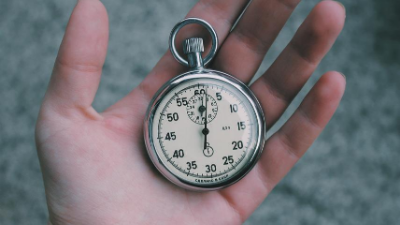 In my previous “Finding Power Through Productivity” blog, I wrote about my experience trying out the Pomodoro Technique. To continue finding the best productivity solution for me, I decided to try out the Flowtime Technique. I’ll share the pros and cons of the method, how it compares to the Pomodoro Technique, and the overall effectiveness of the method.
In my previous “Finding Power Through Productivity” blog, I wrote about my experience trying out the Pomodoro Technique. To continue finding the best productivity solution for me, I decided to try out the Flowtime Technique. I’ll share the pros and cons of the method, how it compares to the Pomodoro Technique, and the overall effectiveness of the method.
What is the Flowtime Technique?
The Flowtime Technique is similar to the Pomodoro Technique, as you:
- Break up your workday into focused segments
- Take a break
- Repeat
However, the difference between the Pomodoro and Flowtime Techniques is that the Pomodoro has a set time—25 minutes—for how long you work, with defined short and long breaks in-between the 25-minute segments (reference last month’s blog to see the breakdown). When using the Pomodoro Technique, I found that I would often be in the middle of a task when the timer would go off, which interrupted my train of thought. With the Flowtime Technique, you pick one task to focus on (referred to as “unitasking”) and then just take breaks when you feel they are needed to achieve a balanced workflow. You can use a stopwatch to track how long you work on certain tasks.
Why is this method said to be effective?
The goal of the Flowtime Technique is to have an uninterrupted—you guessed it—flow. You are in charge of when and for how long you take breaks. This means there are no interruptions for a mandatory break, but you will always have a break when you need one. When researching the Flowtime Technique, I found a quote from a Zapier article that I thought summed up the Flowtime Technique well. The author wrote that “the best productivity technique, like the best food, is personalized.” The Pomodoro Technique is effective in tackling tasks where you don’t need to get into a state of flow (for example, when typing data into a spreadsheet). However, when you need to engage fully in a task that isn’t as mindless, it is often more effective to work without interruption and refresh yourself on your own terms.
How did you use the technique day-to-day?
In the morning, I would look at Monday (my team’s project management software) to view my task timeline and the most important tasks of the day. After prioritizing what tasks I needed to work on, I used an Excel spreadsheet to create a Flowtime Chart and list my tasks for the day. For each task, I would note:
- The task start time
- The task end time
- How many interruptions I had while completing the task
- The total amount of time I worked on the task for
- The total amount of time I took breaks for while doing the task
- Where I was working at
I decided to note these specific things based on research I had done. The research said that tracking certain aspects of your workflow can help you figure out where you work well and with minimal interruption, what tasks fatigue you more quickly, and how long a task typically takes you (including breaks and occasional interruptions).

How do I know how long to take breaks for?
This really depends on personal preference, but I would take breaks when:
- My Apple Watch was telling me I had been sitting too long
- I finished a lengthy task
- I had been working on a task and was starting to feel fatigued
This Flowtime Technique “Cheat Sheet” (which is a GREAT resource for a basic breakdown of the method) recommends a general outline of when to take breaks, but says to adjust as needed:
- 3-minute break for up to 25 minutes of work
- 5-minute break for up to 40 minutes of work
- 7-minute break for up to 60 minutes of work
- 10-minute break for up to 80 minutes of work
- 15-minute break for anything over 80 minutes of work
Again, this is a suggested, rough outline—it’s really up to you and your preferences.
What were your findings?
Journal Entries:
- July 1: I am eager to see how/if the Flowtime Technique helps my productivity. I like the general idea of the Pomodoro Technique…but the timer just gets. on. my. last. nerve. I seriously audibly screamed once when it interrupted a blog writing session where the juices were flowing. So, enough typing…time to try it out!
- July 15: So far, I like the Flowtime Technique. It gives me accountability in eliminating distractions and staying focused on my tasks (putting the productivity in productivity hack, am I right?) And I love that I decide when I want to take a break. I feel like it helps my creativity when brainstorming content and doing tasks that require my mind to be in tip-top creativity mode. However, in all transparency, I do not love filling out the Flowtime Chart. I know that if I were to dissect the spreadsheet, it would probably help me figure out which tasks take more of my time, where I can improve, and which coffee shops I work best at. However, the time it takes to track everything on a spreadsheet is so time-consuming that you need to create a task just for tracking your other tasks! AHH!
- July 27: Here’s my major takeaways of the Flowtime Technique:
- It is a stellar method for keeping me focused and eliminating distractions with minimal interruption and maximum accountability.
- I feel like I am more self-aware of how I am spending my time.
- Unitasking commits me to my work. I feel like this was especially helpful with big tasks that I tackle.
- I know that creating data points on my activity would be helpful and is why many people implement these techniques in their life…but to be honest, it was way too time-consuming to mine highly specific data on my end. However, I did learn that I am typically more energized in the mornings, which was helpful in figuring out when to schedule more difficult, mind-boggling tasks into my day. For me, maybe a less specific system would work slightly better.
Pros:
- Focus is enhanced. Akin to the Pomodoro Technique, setting aside designated time for certain tasks creates a sense of focus at work. Instead of hopping around between multiple tasks, your attention is given to one specific task; unitasking is typically more effective!
- You can create a better workflow in the future. Seeing when and how long you work on tasks helps you figure out how to allot your time more successfully in the future.
- You have accountability. Tracking how long you are working creates accountability, and the ticking timer eliminates procrastination.
- You’re able to get into a flow state. You will no longer be on the brink of a major idea to have a timer interrupt you. Instead, you’ll be able to fully immerse yourself in the task you are working on with minimal interruption.
Cons:
- Creating a better workflow will take more time and effort than with other productivity methods. Know up-front that you will need to allow time in your schedule to track the details of your workflow. The basics, like seeing how long you work each day, are easy to break down. Figuring out productivity patterns such as how long you typically work after taking breaks, when you feel the most fatigued, etc. can be helpful, but time-consuming.
- Figuring out your “break system” may be easier said than done. Everyone is different, but you may struggle with either feeling like you’re taking too many breaks or focusing so hard to get a task done that you keep going even when you feel fatigued. Regardless, it’s important to take a break when you feel one is needed. There are tips to increase the frequency of your breaks, and if you are on the opposite end of the spectrum, just remember it will take time to figure out the difference between just wanting to check Facebook and needing an actual mental break.
- You MUST plan. You will need to know in advance what tasks you are going to work on and how to prioritize them well. If you are planning to measure their effectiveness, you’ll need to consider the time that managing the data can take.
- Unpredictable schedules and Flowtime aren’t the best combination. If you set your own schedule and never have unplanned tasks and meetings pop up throughout your day, then you will find the Flowtime Technique to be more effective than someone with an unpredictable schedule will. Constant change throughout the workday can make tracking time, breaks, and interruptions difficult.

Who would you recommend the Flowtime Technique to?
- Individuals who work on tasks that require creativity, innovation, problem-solving, brainstorming…really, anything that requires hard mental work
- Individuals who like creating their own structure rather than having a required structure
- Individuals who find themselves easily distracted throughout their workday and are striving for better focus
The Last Word
Just like with the Pomodoro Technique, I would say that the Flowtime Technique is also not for everyone. I recently bought a new Keurig in an attempt to make more coffee at home. Have I made a “perfect” cup of coffee? No. Have I found one that tastes great? Yes, but it took much trial and error. Similarly, I feel there is no “perfect” productivity method, but with trial and error, you can find one that works well with your needs.
Bonus Content: Flowtime Technique Tools
Jessica Greene, a freelance marketing and business writer, shares several digital apps in her research that she found to be helpful:
- Toggl: Best for people who want something that’s as easy to use as pen and paper.
- Available via Web, iOS, Android, macOS, Windows, Linux, Chrome, and Firefox. Pricing varies by plan, but the basic plan is always free.
- TMetric: Best for seeing your daily focus sessions and breaks in a timeline view.
- Available via Web, iOS, Android, macOS, Windows, Linux, Firefox, Chrome, Opera, and Edge. Pricing varies by plan, and a free version is available.
- HourStack: Best for a detailed weekly view of your focus sessions and breaks.
- Available via Web, iOS, and Android. Pricing varies by plan.
- Plans & Pricing: $7 per month for a personal plan and $15 per month for a professional plan, with free trials available and a 20% savings if you purchase annually. Enterprise plan available for large teams.
Of course, you can always go the old fashioned route, and create a chart using pen and paper. Excel is also an option.
And if you need a stopwatch, I recommend using the one on your phone. However, there are several stopwatches available on Amazon.
ABOUT THE AUTHOR:

Hi! My name is Marah Whitaker (think Laura with an M). I am the Marketing Assistant for UTC Center for Professional Education. During the workday, I spend time writing blog posts, creating content for social media, developing email campaigns, and building relationships with our customer base. During my free time, you can find me getting lost in a good book, having spontaneous dance parties, playing piano, and going to Buffalo Wild Wings on Wing Night. Professionally and personally, I aspire to live by the Mr. Feeny quote, “Dream. Believe. Try. Do Good.” I strive to use my passions to serve others and contribute positively to the world around me.
Connect with me on LinkedIn.